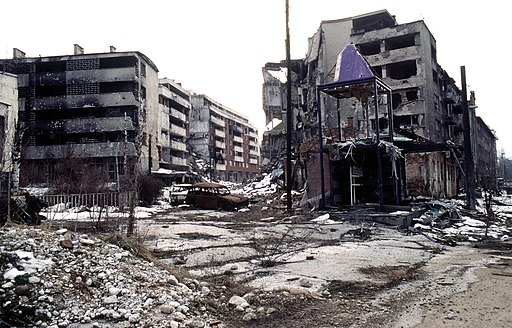In the 1990s, Ratko Mladić was general of the Bosnian Serb army overseeing multiple war crimes, including genocide conducted during the Bosnian Civil War (Weitsman, 2008). Beginning on 6 April, 1992, and continuing until 14 December, 1995, the Bosnian War involved a conflict between Bosnia and Herzegovina. The formerly Yugoslavian territories, including the Slovenian and Croatian areas, broke away from the Socialist Federal Republic of Yugoslavia in 1991. The Socialist Republic of Bosnia and Herzegovina was multiracial (Hayden, 2013), consisting of a large fraction of Muslim Bosniaks (44% of the population), around a third of the population being Orthodox Serbs (32.5%), and a minority of Catholic Croats (17%).
The Bosnian Serb groups and the Yugoslav People’s Army mobilized to capture Serbian territory (Zakošek, 2008). As the war developed, a series of events leading to ethnic cleansing started to occur. The bitter fighting incorporated not only ethnic cleansing and genocide but a systematic mass rape of other ethnic groups, instigated primarily by the Serbian forces. The siege of Sarajevo and the Srebrenica massacre are a marker of the atrocities carried out during the conflict. It has been estimated that up to 50,000 women were raped, with most victims being Bosniak women (Bartrop, 2016).
As the Socialist Federal Republic of Yugoslavia broke up, the various ethnic groups within the region promoted nationalistic goals with the development of ethnically formed nations. Yet, the former Ottoman province faced a crisis as each group sought to maximize territory and capture ground from other ethnic communities. In the first election in Bosnia and Herzegovina, in November 1990, the majority of voting formed along ethnic party lines (Friedman, 2018). As a result, national separatist parties gained regional power and sought to split away from the central federalist system that had been created.
The Serbian Cantons on either side of the country surrounded the Croat and Bosniak regions. The separation of the majority of Serbian forces led to boycotts of referendums and protests throughout the country. As a result, the three factions within the nation split into the Bosnian ethnic group loyal to the Republic of Bosnia and Herzegovina, the Croat groups seeking the formation of the Croatian Republic, Croatia, and the Serb or Yugoslav people who promoted a region that became known as Serbia and Montenegro (Vladisavljević, 2004).
Ethnic cleansing was used against the Bosnian Muslim and Croat groups, who were forced to flee their homes or be expelled by the Serb paramilitary groups. Through a combination of intimidation, murder, and rape, the Bosniak groups were forced out of their homes and became refugees or victims of the ensuing genocide. It is estimated that between one and 1.3 million people were forcibly resettled or deported from the country. In addition, the military forces used rape to intimidate people into leaving their homes and, thus, the country. It is estimated that 90% of the ethnic cleansing during the conflict was conducted by Bosnian Serb forces (Petrovic, 1994).
The use of sexual assault has been referred to as “mass rape” and was utilized as a weapon of war by the Serb police. Additionally, it is known that many Islamic women of the region were captured and involved in sexual enslavement. This crime against humanity is considered second only to genocide. The harassment of minority groups in northern Bosnia was deployed to make people leave, and when people didn’t voluntarily vacate, the mass murder of ethnic groups followed (Kumar, 1997).
As Rieff (1996) contends, the slaughterhouse that became this former nation could have been avoided if the West had acted sooner. Instead, in seeking to avoid conflict, Western forces under the United Nations failed to control a volatile situation that led to the murder and rape of countless individuals. When nations are charged with a role based on the promotion of liberal Western values, it can be necessary at times to interact and engage before problems escalate. Unfortunately, here we see an example by the West of a failure to do so, and the genocide of people seeking to live normally in their birth country.
References
Bartrop, P. R. (2016). Bosnian Genocide: The Essential Reference Guide: The Essential Reference Guide. ABC-CLIO.
Friedman, F. (2018). The Bosnian Muslims: Denial Of A Nation. Routledge.
Hayden, R. (2013). From Yugoslavia to the Western Balkans: Studies of a European Disunion, 1991-2011. BRILL. https://doi.org/10.1163/9789004241916
Kumar, R. (1997). Divide and Fall?: Bosnia in the Annals of Partition. Verso.
Petrovic, D. (1994). Ethnic Cleansing—An Attempt at Methodology. European Journal of International Law, 5, 342.
Rieff, D. (1996). Slaughterhouse: Bosnia and the Failure of the West. Simon and Schuster.
Vladisavljević, N. (2004). Yugoslavia’s successor states (P. Calvert, Ed.; pp. 390–398). John Harper Publishing. http://www.johnharperpublishing.co.uk/pp005.shtml
Weitsman, P. A. (2008). The Politics of Identity and Sexual Violence: A Review of Bosnia and Rwanda. Human Rights Quarterly, 30(3), 561–578.
Zakošek, N. (2008). Democratization, State-building and War: The Cases of Serbia and Croatia. Democratization, 15(3), 588–610. https://doi.org/10.1080/13510340801991130
(Image: View of Grbavica, LT. STACEY WYZKOWSKI, Public domain, Wikimedia Commons)

